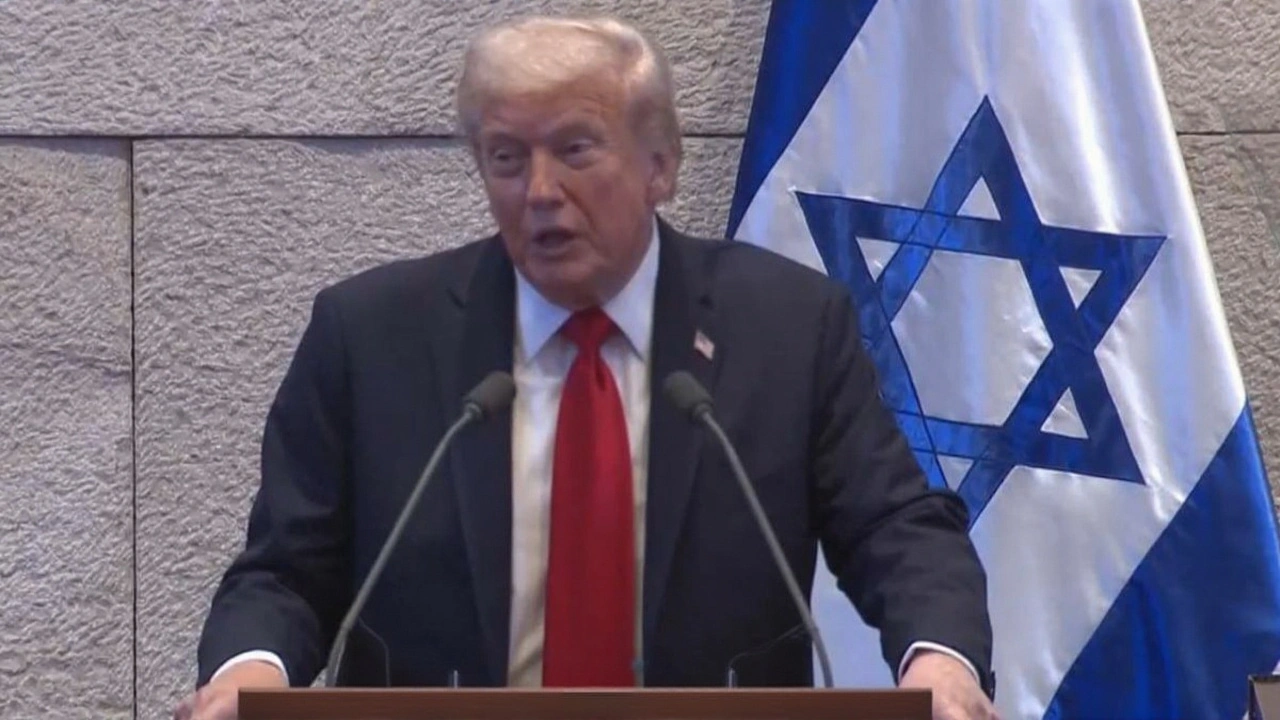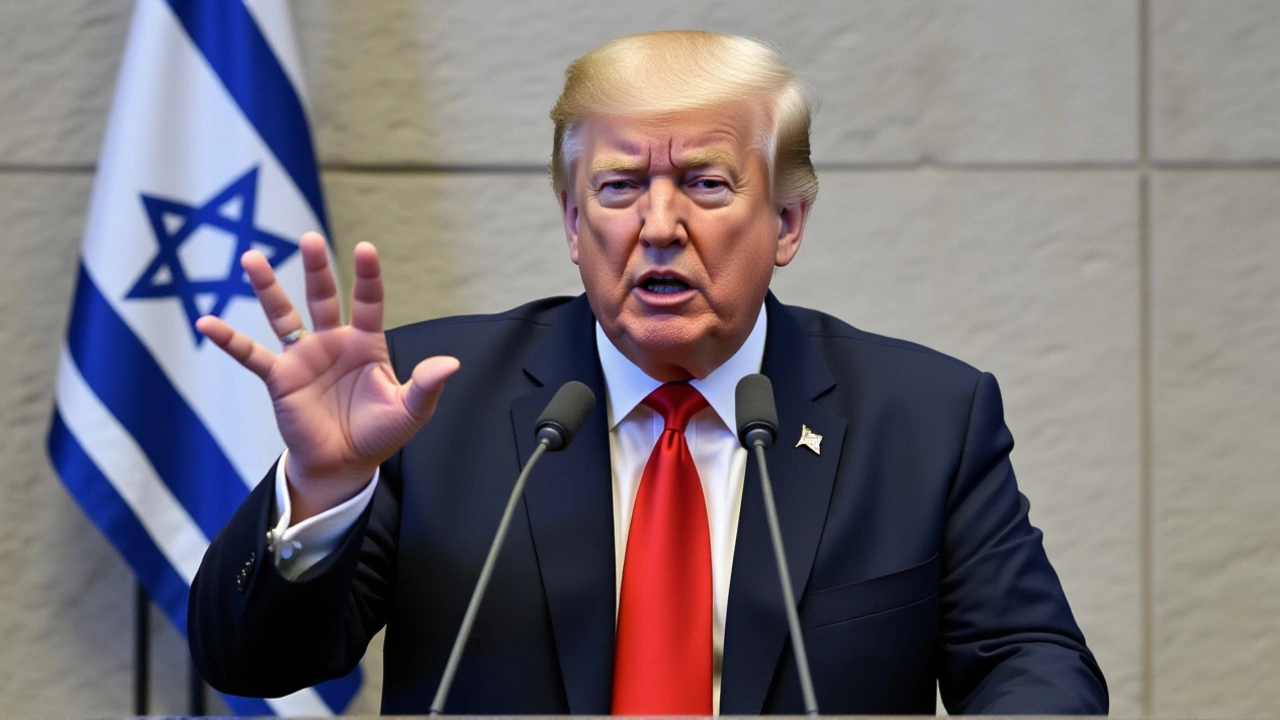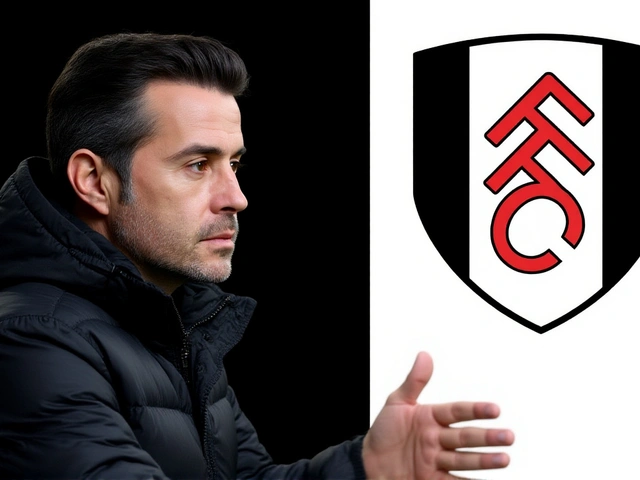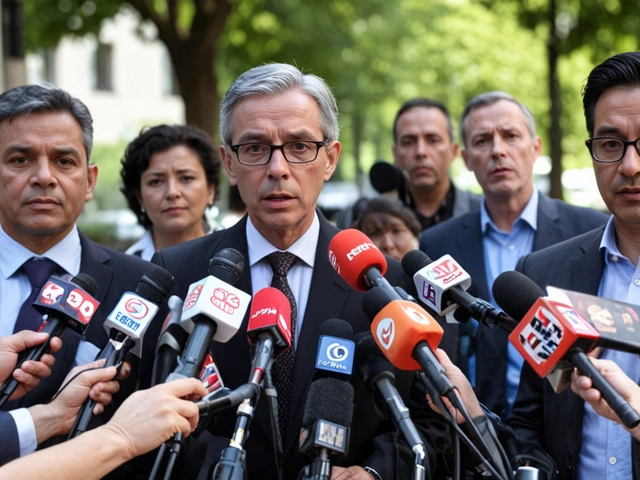When Donald Trump, President of the United States stepped onto the podium of the Knesset in Jerusalem on , he declared that the war is over. The statement came minutes after the final three hostages—taken during the October 7, 2023 Hamas assault—were released in a U.S.-brokered cease‑fire and exchange agreement that also promised a halt to large‑scale fighting.
Background to the Conflict
The October 7 attack by Hamas saw more than 1,400 Israelis killed and roughly 250 civilians captured and taken to the Gaza Strip. Over the next two years, Israel launched a series of ground and air operations that left at least 8,300 Palestinians dead, according to United Nations estimates. International pressure to secure the release of the hostages intensified, especially after the first wave of 104 captives was freed in December 2023 under a limited truce.
Negotiations stalled for months as Benjamin Netanyahu, Prime Minister of Israel balanced military objectives with humanitarian concerns. By early 2025, the United States, under Trump’s administration, re‑entered the talks, positioning itself as the sole mediator willing to offer a concrete pathway for a hostage swap.
The U.S.-Brokered Ceasefire and Hostage Deal
On September 30, 2025, U.S. diplomats presented a draft agreement that would exchange 1,200 kilograms of humanitarian aid for the remaining 107 Israeli hostages still held in Gaza. The plan also stipulated a 90‑day ceasefire, monitored by a joint Israeli‑U.S. team, and a commitment from Hamas to halt rocket launches.
When the final three captives walked out of the Rafah crossing on the morning of October 13, the world watched. Trump, who arrived in Tel Aviv the previous night, met the freed families in a moving gathering at the Israeli Defense Forces’ headquarters. "These brave men and women, and their families, have endured a nightmare we could not imagine," Trump said, his voice reverberating through the crowded hall.
The ceasefire, effective at 0600 GMT on October 13, was celebrated with a joint press conference in the Knesset’s Grand Hall. The agreement also included a provision for a phased reconstruction fund of $2.3 billion, earmarked for Gaza’s devastated infrastructure.
Reactions Inside Israel
Amir Ohana, Speaker of the Knesset rose to give a standing ovation, describing Trump as "a colossus who will be enshrined in the pantheon of history." The applause lasted for nearly two minutes, reflecting the emotional release felt by many legislators.
Netanyahu, flanked by senior ministers, praised the deal as "the culmination of relentless effort and hard‑won sacrifice." In his remarks, he noted, "The most difficult work was that of the prime minister – deciding when to be hard on Hamas and when to show restraint. Without those decisions, we would not be here today."
Public opinion polls released by the Israel Democracy Institute on October 14 showed a 68% approval rating for the ceasefire among Israeli voters, a notable rise from 45% just a month earlier.
International Perspective
European diplomats were quick to acknowledge the diplomatic breakthrough. Josep Borrell, EU High Representative for Foreign Affairs and Security Policy said, "The release of the hostages is a humanitarian triumph, and we commend the United States for facilitating this outcome. However, we remain cautious about the durability of the cease‑fire without a clear path to Hamas’s disarmament."
Analysts in Washington, such as Michael O'Hanlon, senior fellow at the Brookings Institution, warned that "the real test will be whether the 90‑day pause can evolve into a political settlement that addresses the underlying grievances of both sides."
Conversely, critics in the United Nations highlighted the lack of a firm mechanism for verifying Hamas’s adherence to the agreement, noting that similar pauses in 2021 had collapsed within weeks.

Challenges Ahead
While the immediate humanitarian crisis has eased, several thorny issues remain unresolved. First, the agreement does not require Hamas to surrender its arsenal, leaving Israel vulnerable to future rocket attacks. Second, the reconstruction fund for Gaza is contingent on transparent oversight, a point of contention between Israeli officials and Palestinian authorities.
Furthermore, Iran’s reaction—issuing a stern statement warning against "U.S. interference"—suggests that regional dynamics could still destabilize the fragile peace. Experts like Dr. Ayelet Shaked, professor of Middle‑East studies at Tel‑Aviv University, argue that "without a comprehensive regional security framework, any ceasefire remains a temporary bandage."
Nevertheless, Trump’s bold proclamation that the war is over has reshaped the diplomatic narrative. Whether this moment marks a genuine turning point or a brief interlude will depend on the next few months of implementation.
What Comes Next?
The joint Israeli‑U.S. monitoring team is set to begin its first patrol of the Gaza border on October 15, aiming to verify the cessation of hostilities. Simultaneously, humanitarian convoys funded by the reconstruction package are scheduled to arrive in Rafah by the end of the month.
Political leaders in both Jerusalem and Washington have signaled a willingness to convene a broader Middle‑East summit later this year, hoping to involve Egypt, Jordan, and Saudi Arabia in discussions about a lasting peace framework.
Frequently Asked Questions
How does the ceasefire affect Israeli civilians?
The ceasefire immediately halted rocket fire from Gaza, allowing residents of southern Israeli towns to return to their homes without the constant threat of air‑raid sirens. Schools in the affected districts have reopened, and the Israeli government estimates that daily economic activity in the south could rebound by up to 20% during the 90‑day pause.
What are the conditions for Hamas under the new agreement?
Hamas agreed to cease all rocket launches and to allow the joint monitoring team unfettered access to key crossing points. However, the deal does not compel the group to surrender its weapons, a point that many analysts see as a potential loophole that could be exploited later.
Will the U.S. reconstruction fund be fully delivered?
The $2.3 billion reconstruction package is tied to quarterly audits conducted by a consortium of United Nations agencies and Israeli NGOs. Early reports suggest that the first tranche of $600 million is already earmarked for water and electricity infrastructure, with delivery expected by mid‑November.
How are regional powers reacting to the ceasefire?
Egypt and Jordan have welcomed the pause, offering to host a regional dialogue on security guarantees. Saudi Arabia, while supportive of humanitarian aid, remains ambiguous about its role, citing concerns over Iran’s influence in Gaza.
What are the next steps for the peace process?
Negotiators plan to convene a trilateral summit in Washington in December, involving Israeli, Palestinian, and U.S. officials. The agenda will focus on a longer‑term ceasefire, economic development, and a framework for addressing the status of Jerusalem.







Rashid Ali October 13, 2025
It’s heart‑warming to finally see a diplomatic victory after two years of endless bloodshed. The release of the last three hostages feels like a small miracle in a region that’s been drenched in tragedy. I think many families can finally breathe a sigh of relief and start the long process of healing. The cease‑fire, even if tentative, offers a rare window for humanitarian aid to flow into Gaza without constant interruptions. It also gives Israeli civilians a chance to return to their homes without the constant drone of air‑raid sirens. Rebuilding efforts, funded by that $2.3 billion package, could lay the groundwork for a more stable future if managed transparently. The joint monitoring team is a good idea, but its effectiveness will hinge on real‑time cooperation from both sides. Let’s not forget the psychological scars on the hostages themselves, who will need extensive support to reintegrate. While the political elite celebrate, the ordinary people on both sides are the ones who will suffer if the peace crumbles. Regional actors like Egypt, Jordan, and Saudi Arabia have a responsibility to keep the dialogue alive. Iran’s warning shows that external pressures could still destabilize the fragile calm. The next few months will be a litmus test for whether this cease‑fire can evolve into a genuine political settlement. If successful, it could be a blueprint for resolving other protracted conflicts in the Middle East. If it fails, the world will be back to square one, with even deeper mistrust. In any case, the world should watch closely and support any genuine steps toward lasting peace.
Tanvi Shrivastav October 22, 2025
Well, look who decided to show up with a "war is over" banner-just in time for the photo op. 🙄 It’s almost as if the whole thing was staged for the headlines. I can’t help but marvel at the sheer audacity, but hey, at least the hostages are home, right? Maybe next time they’ll bring a magic wand to fix everything else. :)
Anil Puri October 30, 2025
Really? You think this "deal" solves anything? The cease‑fire is just a pause button, not a solution. Hamas still has its arsenal, and Israel’s still on edge. History shows these temporary fixes always collapse. Yeah, the hostages are back, but the underlying grievances remain untouched. It’s a truce, not a peace treaty.
Mukesh Yadav November 8, 2025
They’re hiding the real agenda, marked? The U.S. is just protecting its own interests, planting a foothold in the region. This "reconstruction fund" is a front for deeper control. And don’t get me started on the alleged “neutral” monitoring team-they’re definitely leaning one way. Wake up, people, before it’s too late!
Bhaskar Shil November 16, 2025
The operationalization of a joint monitoring framework necessitates a robust inter‑agency liaison matrix. Leveraging cross‑functional synergies will mitigate compliance gaps and enhance situational awareness. Stakeholder alignment is pivotal for the translational efficacy of humanitarian convoys. In essence, the success hinges on systemic integration and adaptive governance.
Halbandge Sandeep Devrao November 24, 2025
From a strategic policy analysis standpoint, the declaration of an end to hostilities appears premature. The absence of a verifiable disarmament protocol for Hamas introduces a non‑trivial risk vector. Moreover, the $2.3 billion allocation lacks a granular audit trail, potentially undermining fiduciary accountability. While the humanitarian impetus is commendable, the long‑term stability of the region remains contingent upon a comprehensive settlement framework. In sum, the current arrangement is a provisional measure, not a definitive resolution.
Deepak Verma December 3, 2025
This looks like a band‑aid solution. It might work for a while, but the core issues are still there. We’ll see how long it lasts.
poornima khot December 11, 2025
Rashid’s points are largely spot on; the cease‑fire does provide a crucial window for aid. However, as you noted the long‑term political settlement is still missing, and that’s a big challenge. Let’s hope the international community keeps the pressure on for a sustainable solution.